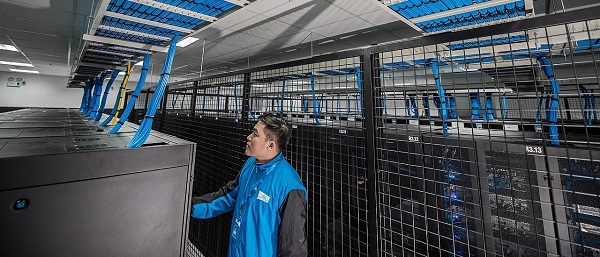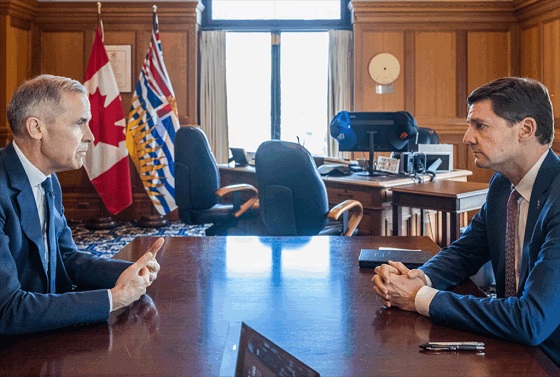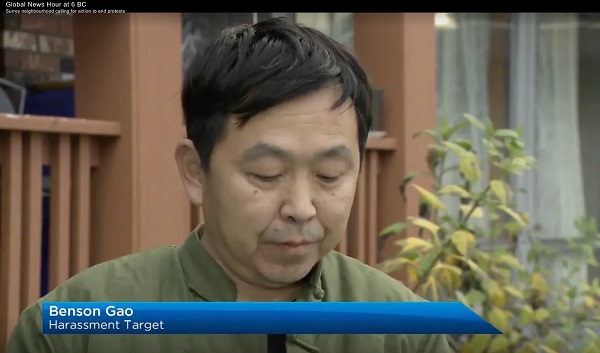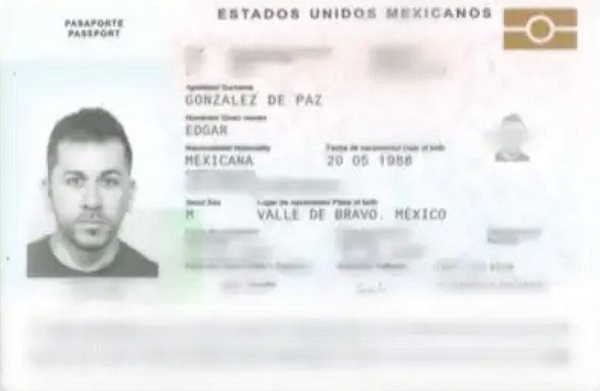Energy
Energy investors see less opportunity in Canada compared to the United States

From Resource Works
Despite Prime Minister Mark Carney’s words of encouragement and the plan to make Canada an “energy superpower,” the country’s energy industry is still falling behind the United States.
The clearest proof of this disturbing trend came straight from one of Canada’s biggest energy infrastructure companies. On a recent earnings call, François Poirier, CEO of TC Energy, flat out said that despite Ottawa’s rhetoric and Bill C-5 to speed up infrastructure development, TC Energy sees more investment opportunities south of the border.
Poirier said, “risk adjusted returns in the U.S. are meaningfully higher than in Canada,” clearly showing a lack of confidence in Canada’s energy sector.
This lack of confidence persists despite several positive developments. Carney’s appearance at the Calgary Stampede, where he said a new west coast pipeline is “highly likely,” seemed good. Alberta Premier Danielle Smith’s “grand bargain” in June, pairing pipeline development with big green investments, also looked like a boost for infrastructure.
But Canada has still not fully committed to fresh pipeline and LNG infrastructure, and it’s holding the country back at the worst time.
As TC Energy is investing in the U.S., Canada is sitting idle, missing out on big economic opportunities. The U.S.-EU trade deal signed in July 2025 is a perfect example: it promises American LNG exports to Europe of $250 billion annually for the next three years.
That’s a huge missed opportunity for Canada, especially on the Atlantic coast, where former Prime Minister Justin Trudeau repeatedly said LNG exports were not viable. His stance culminated in Canada losing contracts to countries like Qatar, while American companies cashed in on the demand generated by Russia’s 2022 invasion of Ukraine.
On the Pacific side, Canada finally saw the first shipment from LNG Canada’s Kitimat plant leave on July 1. Backed by global giants like Shell and Petronas, this facility is well positioned to serve Asian markets.
In fact, shipments from Canada to Asia take half the time of U.S. Gulf Coast exports. ASEAN countries, including the Philippines, have shown interest in Canadian LNG, and that’s another big opportunity for Canada to seize.
But projects like Cedar LNG and Woodfibre LNG are moving slowly and uncertainly, while American LNG facilities along the Gulf Coast and potential Alaskan LNG projects championed by President Donald Trump are expanding fast.
Trump’s tariffs have made it even more urgent for Canada to diversify its energy trade. With Canadian industries like softwood lumber facing 45 percent duties and oil and gas facing 10 percent tariffs, the country needs alternative export routes and markets.
Public opinion is in favour of expansion and diversification, with 91 percent of Canadians supporting increased oil and gas exports according to a recent Nanos poll. But Canada’s regulatory environment, with bills like C-69 and strict emissions caps, is still stifling investment and investor confidence.
The Fraser Institute found in 2023 that 68 percent of North American energy executives view Canadian environmental regulatory uncertainty as a deterrent, much higher than in the U.S.
The economic consequences are severe. Canada’s resource sector contributed 14.9 percent of national GDP in 2023, employed 1.3 million Canadians, and generated nearly half of all business investment. But underinvestment is glaring: since 2015, investment in major resource projects has dropped from $711 billion to $572 billion in 2023, according to Natural Resources Canada.
This decline is directly correlated to Canada’s slow economic growth and global competitiveness.
Historical perspective puts this missed opportunity in context. Canada was once the go-to destination for resource investors; a 1955 issue of Mechanix Illustrated touted Canada as an investment opportunity.
Today, regulatory and political hurdles have turned Canada’s strong environmental standards into a liability, and investors are fleeing to more predictable and welcoming jurisdictions like the U.S.
Meanwhile, the U.S. is taking advantage of Canada’s shortcomings. American LNG exports are projected to reach 150 million tonnes annually by 2029, which is 11 times Canada’s projected capacity. Canada’s hesitation to develop infrastructure not only restricts economic potential but, ironically, contributes to more global emissions as countries revert to coal when natural gas is not available.
Canada’s natural resources should be its ace in the hole. Governments must realize that economic prosperity, national security, and environmental goals are not at odds. Until Canada simplifies regulations, builds energy infrastructure, and regains investor trust, it will always be behind a neighbour that has no problem saying yes.
Artificial Intelligence
AI Faces Energy Problem With Only One Solution, Oil and Gas


From the Daily Caller News Foundation
Which came first, the chicken or the egg? It’s one of the grand conundrums of history, and it is one that is impacting the rapidly expanding AI datacenter industry related to feeding its voracious electricity needs.
Which comes first, the datacenters or the electricity required to make them go? Without the power, nothing works. It must exist first, or the datacenter won’t go. Without the datacenter, the AI tech doesn’t go, either.
Logic would dictate that datacenter developers who plan to source their power needs with proprietary generation would build it first, before the datacenter is completed. But logic is never simple when billions in capital investment is at risk, along with the need to generate profits as quickly as possible.
Dear Readers:
As a nonprofit, we are dependent on the generosity of our readers.
Please consider making a small donation of any amount here.
Thank you!
Building a power plant is a multi-year project, which itself involves heavy capital investment, and few developers have years to wait. The competition with China to win the race to become the global standard setters in the AI realm is happening now, not in 2027, when a new natural gas plant might be ready to go, or in 2035, the soonest you can reasonably hope to have a new nuclear plant in operation.
Some developers still virtue signal about wind and solar, but the industry’s 99.999% uptime requirement renders them impractical for this role. Besides, with the IRA subsidies on their way out, the economics no longer work.
So, if the datacenter is the chicken in this analogy and the electricity is the egg, real-world considerations dictate that, in most cases, the chicken must come first. That currently leaves many datacenter developers little choice but to force their big demand loads onto the local grid, often straining available capacity and causing utility rates to rise for all customers in the process.
This reality created a ready-made political issue that was exploited by Democrats in the recent Virginia and New Jersey elections, as they laid all the blame on their party’s favorite bogeyman, President Donald Trump. Never mind that this dynamic began long before Jan. 20, when Joe Biden’s autopen was still in charge: This isn’t about the pesky details, but about politics.
In New Jersey, Democrat winner Mikie Sherrill exploited the demonization tactic, telling voters she plans to declare a state of emergency on utility costs and freeze consumers’ utility rates upon being sworn into office. What happens after that wasn’t specified, but it made a good siren song to voters struggling to pay their utility bills each month while still making ends meet.
In her Virginia campaign, Democrat gubernatorial winner Abigail Spanberger attracted votes with a promise to force datacenter developers to “pay their own way and their fair share” of the rising costs of electricity in her state. How she would make that happen is anyone’s guess and really didn’t matter: It was the tactic that counted, and big tech makes for almost as good a bogeyman as Trump or oil companies.
For the Big Tech developers, this is one of the reputational prices they must pay for putting the chicken before the egg. On the positive side, though, this reality is creating big opportunity in other states like Texas. There, big oil companies Chevron and ExxonMobil are both in talks with hyperscalers to help meet their electricity needs.
Chevron has plans to build a massive power generation facility that would exploit its own Permian Basin natural gas production to provide as much as 2.5 gigawatts of power to regional datacenters. CEO Mike Wirth says his team expects to make a final investment decision early next year with a target to have the first plant up and running by the end of 2027.
ExxonMobil CEO Darren Woods recently detailed his company’s plans to leverage its expertise in the realm of carbon capture and storage to help developers lower their emissions profiles when sourcing their needs via natural gas generation.
“We secured locations. We’ve got the existing infrastructure, certainly have the know-how in terms of the technology of capturing, transporting and storing [carbon dioxide],” Woods told investors.
It’s an opportunity-rich environment in which companies must strive to find ways to put the eggs before the chickens before ambitious politicians insert themselves into the process. As the recent elections showed, the time remaining to get that done is growing short.
David Blackmon is an energy writer and consultant based in Texas. He spent 40 years in the oil and gas business, where he specialized in public policy and communications.
Energy
It should not take a crisis for Canada to develop the resources that make people and communities thrive.

From Resource Works
Canada is suddenly sprinting to build things it slow-walked for a decade.
“Canada has always been a nation of builders, from the St. Lawrence Seaway to Expo 67. At this hinge moment in our history, Canada must draw on this legacy and act decisively to transform our economy from reliance to resilience. We are moving at a speed not seen in generations,” announced Prime Minister Mark Carney at the end of August.
He was echoed by British Columbia Premier David Eby shortly after.
“There’s never been a more critical time to diversify our economy and reduce reliance on the U.S., and B.C. is leading the way in Canada, with clean electricity, skilled workers and strong partnerships with First Nations,” the premier stated after his government approved the Ksi Lisims LNG project, led by the Nisga’a nation.
In the face of President Donald Trump’s tariffs, Ottawa has unveiled a first wave of “national projects” that includes an expansion of LNG Canada to 28 million tonnes a year, a small modular reactor at Darlington, two mines, and a port expansion, all pitched as a way to “turbocharge” growth and reduce exposure to a trade war with the United States.
The list notably excludes new oil pipelines, and arrives with rhetoric about urgency and nation-building that begs a simple question: why did it take a crisis to prioritize what should have been routine economic housekeeping?
The most tangible impact of resource projects can be observed in the impact it has on communities. The Haisla Nation is enjoying an economic renaissance with their involvement in the LNG Canada project on their traditional lands, which became operational in June.
Furthermore, the Haisla are set to unveil their own facility, Cedar LNG, in 2028. Already, the impact of employment and strong paycheques in the community is transforming, as former Haisla Chief Councillor Crystal Smith as attested many times.

Former Haisla Chief Councillor Crystal Smith.
“Let’s build a bright and prosperous future for every Canadian and every Indigenous person that wants to be involved, because change never happens inside of our comfort zones, or the defensive zone,” said Crystal Smith at a speech delivered to the 2025 Testimonial Dinner Award on April 24 in Toronto.
Fortunately, the new pro-resource posture has a legislative backbone. Parliament passed the One Canadian Economy Act to streamline approvals for projects deemed in the national interest, a centrepiece of the government’s plan to cut internal trade barriers and fast-track strategic infrastructure.
Supporters see it as necessary in a period of economic rupture, while critics warn it risks sidelining Indigenous voices in the name of speed. Either way, it is an admission that Canada’s previous processes had become self-defeatingly slow.
British Columbia offers a clear case study. Premier David Eby is now leaning hard into liquefied natural gas. His government and Ottawa both approved the Nisga’a Nation-backed Ksi Lisims LNG project under a “one project, one review” approach, with Eby openly counting on the Nisga’a to build support among neighbouring nations that withheld consent.
It is a marked turn from earlier NDP caution, framed by the premier as a race against an American Alaska LNG push that could capture the same Asian markets.
Yet the pivot only underscores how much time was lost. For years, resource projects faced overlapping provincial and federal hurdles, from the Impact Assessment Act’s expanded federal reach to the 2018 federal tanker ban on B.C.’s north coast.
Within B.C., a thicket of regulations, policy uncertainty, and contested interpretations of consultation obligations chilled investment, while political positions on pipelines hardened. Industry leaders called it “regulatory paralysis.” These were choices, not inevitabilities.
The national “go-fast” stance also arrives with unresolved tensions. Ottawa has installed a Calgary-based office to clear and finance major projects, led by veteran executive Dawn Farrell, and is touting the emissions performance of LNG Canada’s expansion.

Dawn Farrell, head of the Major Projects office in Calgary.
At Resource Works, we wholeheartedly endorsed the move, given the proven ability and success of Dawn Farrell in the resource industry. It must also be acknowledged that the major projects office will only be an office unless it meaningfully makes these projects happen faster.
A decade that saw eighteen B.C. LNG proposals produced one major build, and moving to LNG Canada’s second phase is entangled with power-supply constraints and policy conditions. That slow cadence is how countries fall behind.
If the current urgency becomes a steady habit, Canada can still convert this scramble into lasting capacity. If not, the next shock will find us sprinting again, only further from the finish line.
Resource Works News
-

 Daily Caller6 hours ago
Daily Caller6 hours agoUS Nuclear Bomber Fleet Shares Fence With Trailer Park Linked To Chinese Intel-Tied Fraudster
-

 espionage5 hours ago
espionage5 hours agoChinese-Owned Trailer Park Beside U.S. Stealth Bomber Base Linked to Alleged Vancouver Repression Case
-

 Alberta2 days ago
Alberta2 days agoSchool defunding petition in Alberta is a warning to parents
-

 Daily Caller4 hours ago
Daily Caller4 hours agoLaura Ingraham Presses Trump On Allowing Flood Of Chinese Students Into US
-

 Agriculture2 days ago
Agriculture2 days agoBovaer Backlash Update: Danish Farmers Get Green Light to Opt Out as UK Arla Trial Abruptly Ends!
-

 International2 days ago
International2 days agoBBC boss quits amid scandal over edited Trump footage
-

 Daily Caller2 days ago
Daily Caller2 days agoMcKinsey outlook for 2025 sharply adjusts prior projections, predicting fossil fuels will dominate well after 2050
-

 Crime2 hours ago
Crime2 hours agoCBSA Bust Uncovers Mexican Cartel Network in Montreal High-Rise, Moving Hundreds Across Canada-U.S. Border




